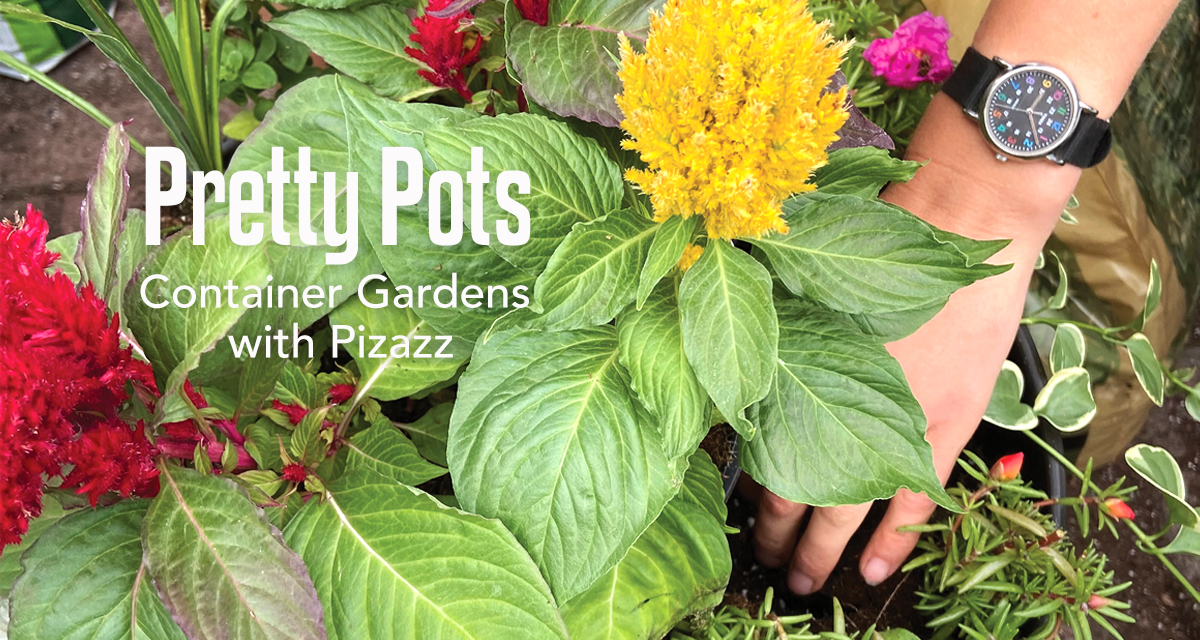Container Gardens with Pizazz
by Dawn Duncan

There is something satisfying about getting your hands a little dirty, especially when the result of such activities is a beautiful, colorful creation all your own. Though it is easy to purchase already-assembled containers, why not try the satisfaction of designing your own? We are here to walk you through it.
Andrea Vanderbilt, owner of Teach Me to Grow, specializes in teaching gardening to homeowners, business teams, schools and organizations through an approachable, hands-on style. She is also an expert garden designer who installs and maintains gardens throughout Northern Colorado.
Here, Vanderbilt offers step-by-step instruction on how to create the perfect patio pot; this particular one is with flowers only, however, Vanderbilt suggests being creative and combining herbs or plants such as strawberries along with flowers for an interesting and useful container.
Step 1:
Select a pot that is sturdy and that has drainage holes in the bottom. Most will come with the holes already present, however, if there are none, simply drill 2 to 3 holes on your own. Placing a few rocks at the bottom of the pot will also assist with proper drainage and allow airflow, thus keeping soil from sitting in stagnant water.

Step 2:
Spacers are a great idea to cut down on the amount of soil that will be needed to fill your pots. If you are doing several containers, this requires a good amount of soil; plastic spacers are inexpensive ($5-15 typically at a garden nursery) and they are set into the pot to shorten the pot’s height so soil is only needed from the spacer’s bottom up to near the top of the container.

Step 3:
Select your soil. Vanderbilt uses a mix between 3 cubic yard bales of compressed soil (such as Berger or Promix, sold at nurseries), with nutrient-rich soil. The bales are inexpensive, yet do not contain nutrients so the mixture with richer soil is key to feed plants properly.

Step 4:
The “tried and true,” common saying when it comes to container planting is “Thriller/Spiller/Filler.” Vanderbilt explains that this means selecting a high-impact, focal point plant is key to create the eye-catching effect needed for your pot’s beauty.
Next, the “spiller” is addedto flow over the edges of the pot and add depth. Here, Vinca Vine is used to soften the pot’s edges and add texture.
Lastly, the “filler” plants, such as the white Petunias, Portulaca (“Moss Roses”), and Cordyline (“spikes”) fill in the gaps around the central plant, the Celosia, with its tall flowers in bright colors.
When putting the pottogether, take plants out of their plastic containers and arrange them before planting. Move them around, create your desired design before actually digging holes or placing plants permanently. The plants should be annuals, which can be packed closely together as they will only be growing for one season, versus perennials which would need more space.

Step 5:
Next, loosen the root ball of each of the plants. Do this gently, by pulling the roots so that they are not as tightly compressed as they were in their store container. Loosening roots is key for growing, as the plant then knows to feed and grow, rather than stay the same size and struggle to gather water or nutrients.

Step 6:
Using a trowel, dig holes for each plant that will comfortably house the plant and allow roots to grow. Keep the soil fairly packed, but not tightly. Arrange loose soil around the plant once it’s in the hole. Continue this process until the container design is complete. Spread loose soil around all plants and brush soil from leaves and petals.

Step 7:
Fertilize your flowers.Vanderbilt recommends using a product such as Osmocote, which is time-released to control feeding and water consumption.
Step 8:
Water the plants.Be sure to not overfill the container with too much soil or it will run out of the pot when you water. Keep the soil moist throughout the summer, but do not water to the point of having excess as it will drown the plants. There should never be standing water in the container. The plants will show if they need more or less hydration (typically, yellow leaves indicate overwatering, whereas dry or wilting leaves show that the plant is thirsty). Plants should be vibrant, upright and growing regularly.
Step 9:
“Deadhead” petals that are past their prime. Pull these off gently and discard.
Step 10:
Make sure to give the proper amount of sunlight daily to ensure your plants thrive.

You have the recipe for pretty container gardens to brighten up the patio and keep color going all summer long.
To reach learn more about Teach me to Grow, visit TeachMeToGrow.com.






